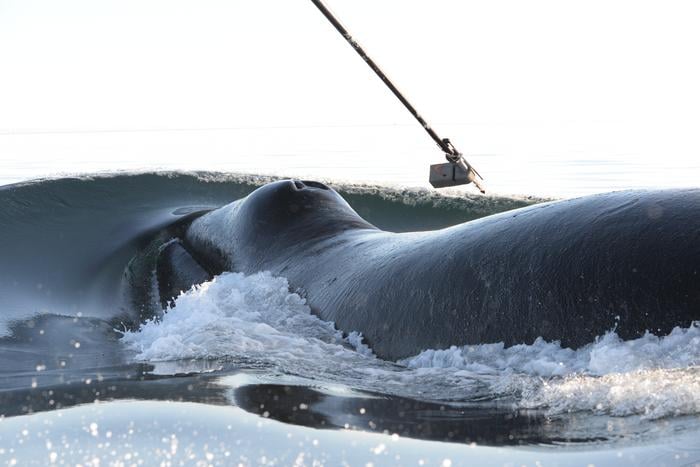A new study has uncovered unexpected patterns in the diving behavior of bowhead whales, suggesting these Arctic giants may be more socially connected than previously thought. The research, set to be published in Physical Review Research, sheds light on the foraging habits and potential long-distance communication of these elusive marine mammals.
Decoding the Chaos of Whale Dives
Bowhead whales, known for their massive size and longevity, have long puzzled scientists with their seemingly erratic diving patterns. To make sense of this apparent chaos, researchers from Japan, Greenland, and Denmark turned to an unlikely tool: chaos theory.
The team analyzed 144 days of diving records from 12 bowhead whales tagged in Disko Bay, West Greenland. By applying principles from dynamical systems theory, they sought to uncover hidden order in the whales’ behavior.
Associate Professor Evgeny A. Podolskiy of Hokkaido University’s Arctic Research Center explains the approach: “Whale diving behavior can be seen as a chaotic, self-sustained oscillation that balances the need for food at depths with the need for oxygen at the surface.”
This innovative method revealed two key findings: a 24-hour diving cycle and evidence of long-range synchronization between whales.
Timed Dives and Long-Distance Dance
The study showed that bowhead whales follow a daily rhythm in their spring diving patterns. Professor Jonas Teilmann from Aarhus University notes, “We find that foraging whales dive deeper during the daytime in spring, with this diving behavior being in apparent synchrony with their vertically migrating prey.”
This behavior, known as diel vertical migration, sees the whales diving deepest in the afternoon to track the daily movement of their prey towards the surface. While this pattern has been observed in other marine species, it hadn’t been confirmed for bowhead whales during the spring season until now.
Perhaps even more intriguing was the discovery of two whales diving in synchrony over distances of up to 100 kilometers. Professor Mads Peter Heide-Jørgensen from the Greenland Institute of Natural Resources describes this unexpected find: “The pair — one female and one of unknown sex — were sometimes as close as five kilometers and sometimes hundreds of kilometers apart, yet they would closely time their diving bouts for durations of up to a week, although to different depths.”
This synchronization occurred when the whales were within acoustic range of each other, which can exceed 100 kilometers. While the researchers didn’t record the whales’ vocalizations, this behavior might support a long-standing theory about acoustic communication in baleen whales.
“The possibility of acoustically connected whales, which seem to be diving alone but are actually together, is mind bending,” Podolskiy remarks. “Our study identifies a framework for studying the sociality and behavior of such chaotically moving, unrestrained marine animals.”
Why it matters: Understanding the behavior of bowhead whales is crucial for conservation efforts and our broader knowledge of Arctic ecosystems. These findings not only provide insights into how these animals forage but also hint at complex social behaviors that span vast distances. As climate change continues to alter the Arctic environment, such information becomes increasingly valuable for protecting these iconic creatures and their habitats.
The study raises several intriguing questions for future research:
1. How widespread is this synchronized diving behavior among bowhead whales and other cetacean species?
2. What specific vocalizations or signals might the whales use to coordinate their dives over such large distances?
3. How might changes in Arctic sea ice and ocean temperatures affect these behaviors?
As technology improves, researchers hope to gather more simultaneous tag data from multiple whales to further investigate these patterns. Future studies might also incorporate acoustic recordings to directly observe any communication between synchronized individuals.
The application of chaos theory to whale behavior opens up new possibilities for studying marine mammals. This approach could be adapted to other species, potentially revealing hidden patterns in the seemingly random movements of ocean life.
As we continue to unravel the mysteries of bowhead whale behavior, we may find that the vast, icy waters of the Arctic are home to a far more intricate and interconnected web of life than we ever imagined. These findings not only deepen our understanding of these magnificent creatures but also highlight the importance of preserving the delicate balance of their ecosystem in the face of rapid environmental change.


